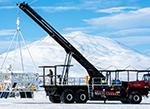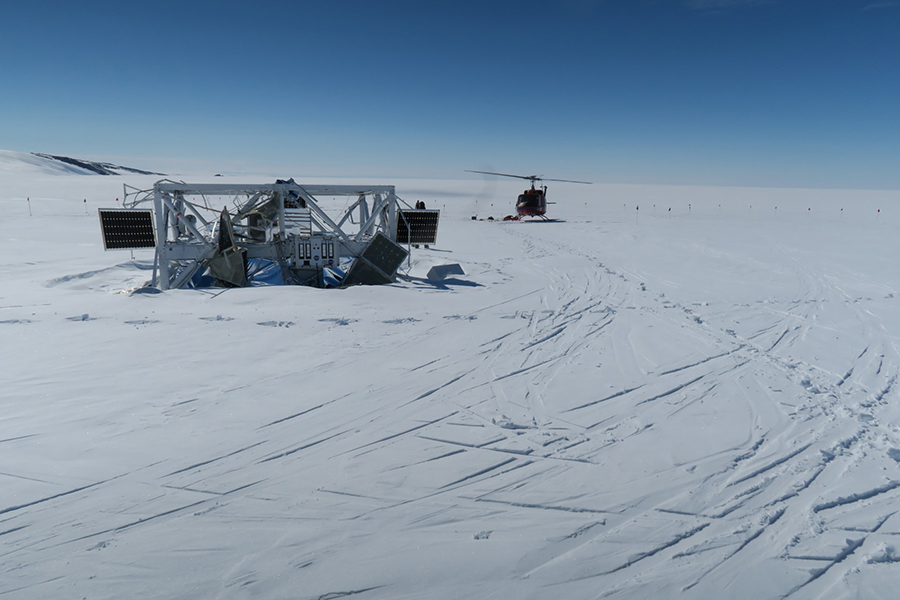
Photo Credit: Ben Adkison |
A helicopter touches down next to the SuperTIGER landing site. The recovery team would spend three hard days retrieving the payload that had to be brought down early. |
Heavy Cosmic Rays - Part II: The Death and Life of SuperTIGER-II
Snatching Victory from the Jaws of Defeat
By Michael Lucibella, Antarctic Sun Editor
Posted September 28, 2020
The season before SuperTIGER-II's successful 2019 flight, the payload had an unexpectedly short flight over Antarctica. Brought down after less than a day because of a problem with the balloon carrying it, it landed in a crevasse field 150 miles from McMurdo Station.
This could easily have ended in calamity. Instead, it led to one of the most daring and complicated recoveries of a long-duration balloon payload in recent memory, turning a near disaster into a triumph.
Less than a year later, the refurbished instrument was again launched from Antarctica, fully repaired and gathering scientific data from more than 120,000 feet above the ground.
"It was an amazing adventure," said Richard Bose, a research engineer at Washington University in St. Louis who was working on the scientific mission.
SuperTIGER-II was launched on December 20, 2018. The first signs of trouble appeared not long after launch, before it reached its intended altitude.
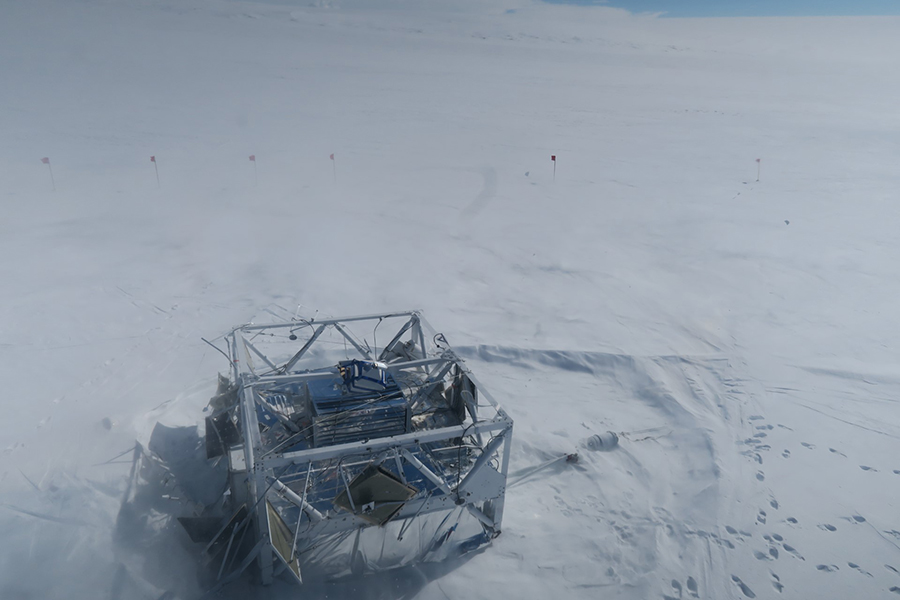
Photo Credit: Ben Adkison
The SuperTIGER payload landed upside-down in a crevasse field. Before retrieval operations could begin, field safety coordinators had to land and inspect the site to make sure it was safe for the recovery team to work there.
"All seemed well, and when we got to about 80,000 feet it stopped ascending and started losing altitude," Bose said. "We were only in the air about six hours."
The Columbia Scientific Balloon Facility team, which operated the launch, had to react fast. They had released all of the ballast from the balloon but still couldn't maintain its altitude.
"It was obvious that something was wrong, so it was intentionally brought down," said Scott Battaion, the Mission assurance supervisor for NASA's Columbia Scientific Balloon Facility which launches the balloons. "We looked for the best location with the amount of time we had."
The team cut the payload from the balloon, which parachuted to the ground on the far side of the McMurdo Dry Valleys, about 150 miles from McMurdo Station.
"We have usually a fair amount of time to know where it's going to go and the whole process just plays out per normal," Battaion said. "This one though, because it was descending at a fast rate, there was obviously something not working correctly. We had maybe two hours to make a decision, and only minutes at one point to bring it down where it was because it was not moving to a better location. It was likely going to go further towards the crevasse fields."

Photo Credit: Richard Bose
Two helicopters drop off recovery team members at the payload landing site.
It was not the ideal location that CSBF would usually aim for. Ordinarily, they try to land the payloads on wide-open fields of ice far away from any potential hazards.
"It landed in the middle of a crevasse field, kind of the only crevasse field for miles in that area," said Ben Adkison, the Field Training Supervisor who helped lead recovery efforts from McMurdo Station. "But from the satellite imagery it looked like it landed right in between two cracks."
Though it landed in a crevasse field the immediate area it was in was by far the least broken up. All around it were areas that were much more dangerous with huge cracks that could have swallowed the payload whole.
"At the time it was a relief to see that the payload did not come down on a mountain or in the water," said Brian Rauch, a research assistant professor of physics at Washington University in St. Louis and the current principal investigator on the project. "Obviously it was concerning to then learn that SuperTIGER was in the midst of a crevasse field, but it was a far better outcome than we might have gotten under those circumstances."
The spot was close enough to the station that teams could reach it by helicopter, but the pieces of the payload were too big to be carried back by helicopter. Instead, the science team and support staff devised a plan to use helicopters to pick up and deposit the payload pieces next to an impromptu airplane landing strip, then load them up onto a plane, and fly back to McMurdo Station.
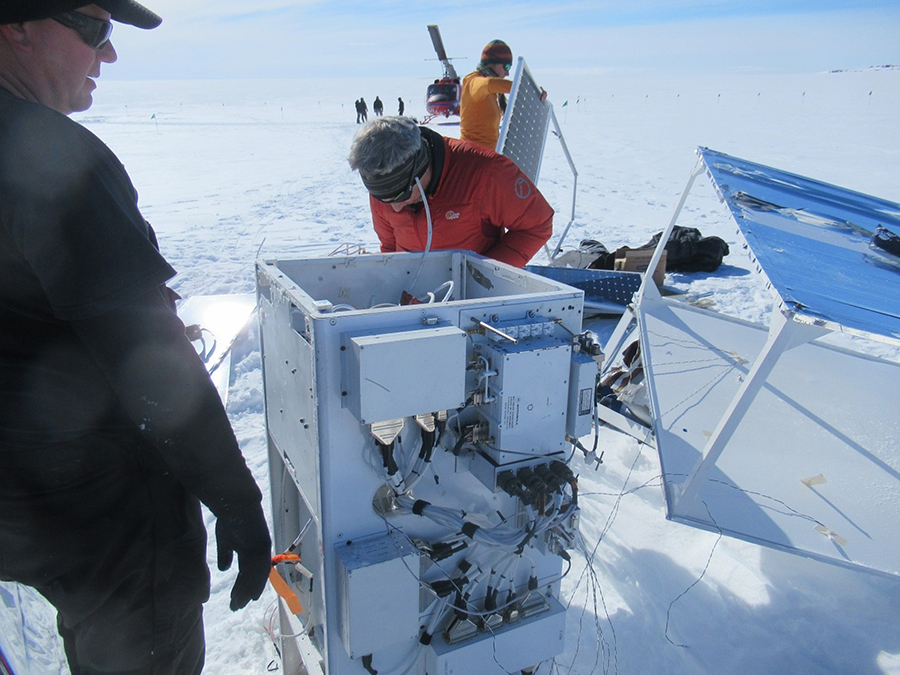
Photo Credit: Richard Bose
Brian Rauch (left) and Scott Battaion work on disassembling a part of SuperTIGER's detector while Kaija Webster picks up a solar panel in the background.
"The payload being upside down in a crevasse field was not a situation we planned for," Rauch said. "I helped devise the plan to do the primary disassembly of the payload and transfer of the gondola and two detector modules using helicopters from the landing site to the nearby compression zone where the [plane] could land."
The first step was to make sure the area around the payload was safe to work in. With all the potential hazards in the area, a team of field safety experts needed to fly out and survey the area before the science team could work on their instruments.
"We wanted to go out there and prove that it was a safe spot to land and walk around in," Adkison said. "There were three of us, myself and two field safety coordinators. We made a plan to probe and GPR [ground-penetrating radar] the area, but that's something we've never really done from a helicopter before."
After a test run near Phoenix Airfield, Ben and his team flew to the landing site. It was a long trip, about an hour and a half by helicopter. When they arrived, the first thing was to see if the snow was safe to walk on. With its blades still spinning, the helicopter touched down, but still essentially hovering so that it didn't put all of its weight on the snow.

Photo Credit: Richard Bose
A helicopter lifts the gondola into the air to relocate it to the Basler landing strip.
"The helicopter would land and stay super light on its skids so if there was a crevasse there, it wouldn't fall in. So it's touching the snow but it's barely touching the snow," Adkison said. "I'm anchored to some rings on the inside of the helicopter. I stepped out onto the skid and then probed right next to the skid so that I could make sure that I could step off of the skid and not fall directly into a crack. Then probed a small working area so I could move around a little bit, and took out the GPR unit."
The probe is nothing more than a long thin stick to poke at the ground below to see if it's secure. The ground-penetrating radar is also a common tool for spotting deep crevasses. The radar emits radio signals into the snow that reflect off of its different layers.
"It gives you warning and real-time data of what's directly below you," Adkison said. "You can see the snow layers stop and there's nothing there."
After Ben was satisfied that the patch of snow next to the helicopter was crevasse-free, the helicopter set down on the cleared area, and Ben and his team continued their work around the area.
"Myself and the two field safety coordinators put skis on, roped up and dragged the GPR around a pretty large area, around the payload the balloon the helicopter and flagged it off," Adkison said.
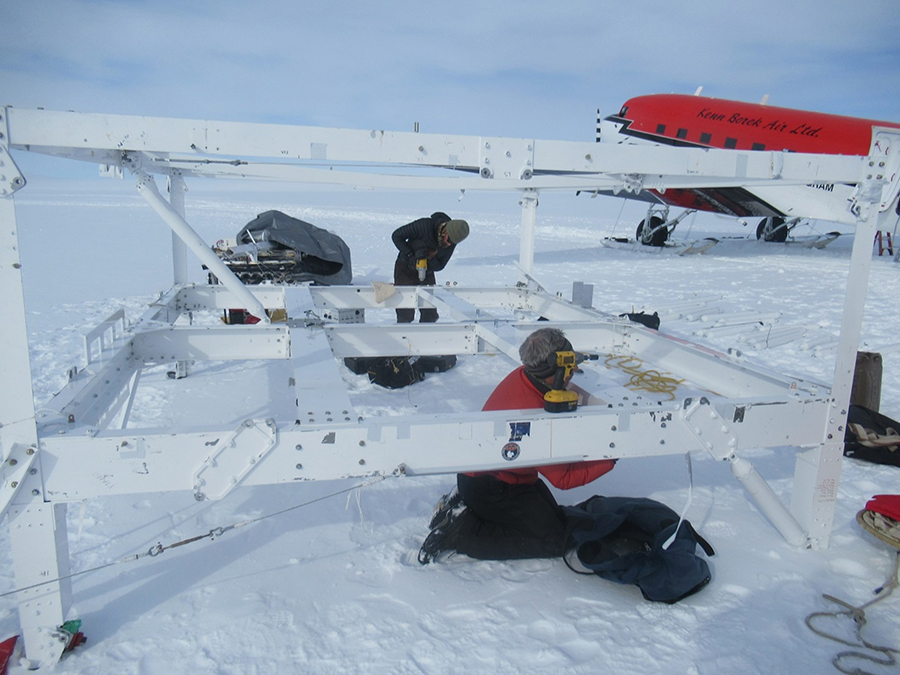
Photo Credit: Richard Bose
Scott Battaion (foreground) and Kaija Webster work to disassemble SuperTIGER's gondola with the Basler in the background.
Inside the flags was the safe zone, the area where the science team could work safely to disassemble the payload and pack it up without fear of any crevasses below.
Before leaving the area entirely, the team flew to another spot about two miles away to survey the proposed landing strip for the ski-equipped DC-3 planes known as Baslers. Their job done, Adkison and his team returned to McMurdo Station and the next phase could begin. With the landing site deemed safe, a full recovery of the payload looked feasible. It would take three trips over three days, and be done in steps.
"We came up with this plan of going out in the helicopters, getting all the little stuff, bringing that back," Bose said. "The second day we would be sling-loading the big pieces, the gondola, and each module over to where the Basler can land and take them apart and cram them in there."
That first day, the recovery team pulled off the small items like data recorders and antennas to bring back on the helicopter and started to detach the detector modules off of the gondola, the metal truss that all of the scientific instruments are mounted on.
"That mission was the initial breakdown and preparation of the payload for the helicopters to pick it up," Battaion said. "That involved four people from CSBF and the science group and the flight crews of the helicopters that were assisting."
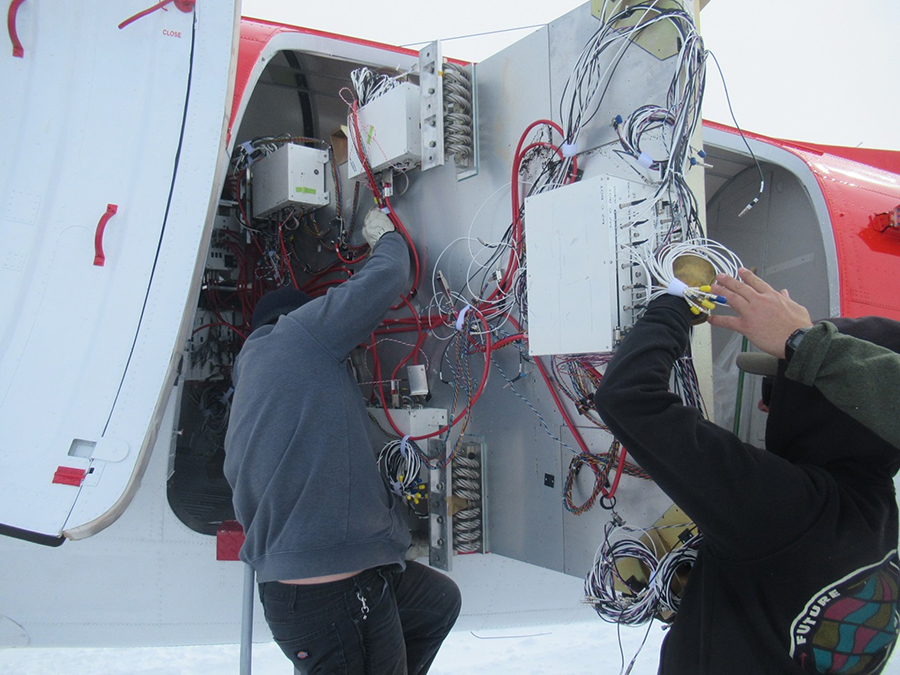
Photo Credit: Richard Bose
Two of the Basler crewmembers lift parts of the disassembled detectors into the plane.
The following day, the recovery team's goal was to move the instrument by helicopter to the Basler landing site. The payload landed upside-down, actually making it easier for the team to separate the gondola from the detectors.
"At that point we had already separated the detector modules from the gondola, and it was mostly moving those three big components and a bunch of loose load from the impact site to the Basler site where it could then be broken down further and put in the airplane and brought back to McMurdo," Battaion said.
The team set about prepping the three pieces for the helicopter to pick them up and carry them to the Basler landing site two miles away.
"[We] took the cables off, unbolted the modules and then the helo crew worked their magic and rigged it up," Bose said
The helicopter gingerly lifted the gondola off of the two instrument modules and set off towards the Basler landing site. After all sections of the payload were safely delivered to the landing strip, the team covered them in tarps and returned to the station.
"That second day where the helicopters lifted the gondola off of the modules and then slung the modules themselves was glorious," Rauch said. "It was a profoundly gratifying to see my plan work."
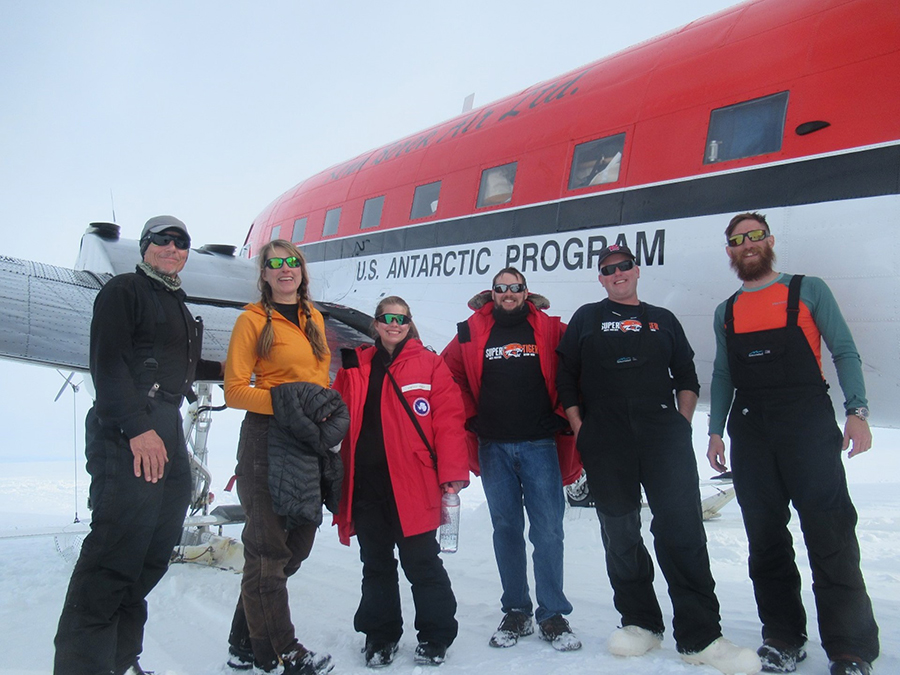
Photo Credit: Richard Bose
The recovery team pose next to a Basler at the landing strip. Left to right: Scott Battaion, Kaija Webster, Lindsey Lisalda, Richard Bose, Brian Rauch and Andrew West.
The final trip out would be the biggest day. Arriving in the Basler, the team set about breaking down the gondola and instrument modules even further so they could fit inside the doors of the plane.
"The detector modules are a stack of different types of detectors, so we had to un-cable it and then you can unbolt each of the detector layers. The biggest one is 250 pounds," Bose said. "We had to dismantle it to both fit it in the Basler, and to lift it into the Basler."
With no room in the plane or helicopters for heavy lifting equipment, everything had to be picked up and moved by hand. The gondola alone weighs about 1,000 pounds, and each detector module another 1,500 pounds or so each. The team set about their respective tasks, but when it came time to pick up the heavy pieces and lift them the six feet into the doors of the Basler, everyone lent a hand.
"Four of us focused on the modules, the other two on the gondola," Bose said. "We really did need six people, everyone kept real busy. I was exhausted."
After seven long hours of hard work, all 4,000 pounds of the payload had been loaded on board the Basler and was safely flying back to McMurdo Station. They brought along two graduate students from the X-Calibur balloon project to help pack up the plane.
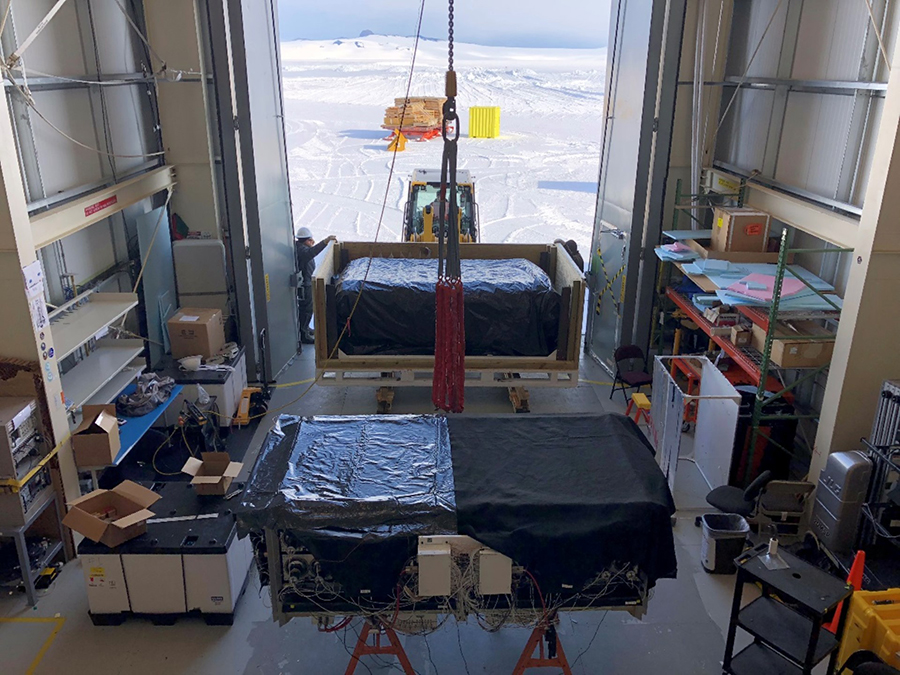
Photo Credit: Richard Bose
Back at the Long Duration Balloon Facility at McMudro Station, the team went through and tested the instrument's components to see what worked and what needed to be replaced.
"The third day was a deeply wearying slog to get everything broken down and on the Basler, and I was surprised that we managed to complete it all in the time allowed," Rauch said. "We could not have done it without all of the extra help from Andrew West, Lindsey Lisalda, and the Basler crew."
Back at the station's long-duration balloon facility, the science team tested many of the instruments to see if anything had been irreparably broken from the landing.
"The intention is to turn it on as much as we can, and get as good an idea as we can of what to fix," Bose said. "You never know, something might have a long lead time so the sooner you know the better."
They then repacked everything once again to ship back to the United States. NASA granted the project collaboration the opportunity to try again. Over the next year, the team refurbished SuperTIGER and were able to successfully launch again on December 16, 2019.
The SuperTIGER project is a collaboration among Washington University in St. Louis, NASA's Goddard Space Flight Center, Caltech, and JPL, funded by grants from NASA.





